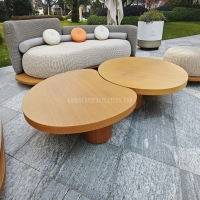Welcome to the website for landscape facilities products and knowledge.
What are the key factors influencing the table’s resistance to damage from outdoor pollutants?
The longevity of outdoor tables when exposed to environmental pollutants depends on several critical factors that work in concert to provide protection. Material selection stands as the primary defense mechanism, with certain substances inherently possessing superior resistance qualities. Powder-coated aluminum, for instance, creates an impermeable barrier against moisture and chemical contaminants, while teak wood naturally contains oils that repel water and resist fungal growth. Synthetic materials like polywood and high-density polyethylene offer exceptional durability against UV radiation and acidic deposits.
The manufacturing process and applied finishes significantly enhance a table's defensive capabilities. Advanced powder coating techniques create a uniform, bonded layer that prevents chipping and peeling more effectively than traditional paint. Marine-grade varnishes, specifically formulated for outdoor use, provide ultraviolet protection while allowing wood to breathe naturally. Anodized aluminum surfaces undergo electrochemical processes that harden the material, creating a surface highly resistant to corrosion and pitting from airborne pollutants.
Environmental conditions and maintenance routines play equally crucial roles in determining resistance. Tables installed in coastal regions face salt spray that accelerates corrosion, necessitating more frequent protective treatments. Regular cleaning with pH-neutral solutions prevents the accumulation of acidic pollutants that can degrade protective coatings over time. Proper storage during extreme weather events or off-season periods dramatically extends furniture lifespan by reducing constant exposure to damaging elements.
The structural design of outdoor tables also contributes to their resilience. Water drainage channels, slatted surfaces, and elevated bases prevent stagnant water accumulation that leads to mold and material degradation. Tightly sealed joints and stainless steel fasteners resist moisture penetration at connection points, addressing common failure areas. Understanding these interconnected factors enables informed decisions when selecting and maintaining outdoor tables, ensuring optimal performance against environmental pollutants throughout their lifespan.
Related search:

Recommendation
Elliptical metal outdoor table with nested design, resembling wood grain, round table